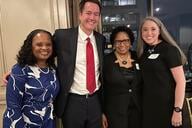You have /5 articles left.
Sign up for a free account or log in.
Colleges and universities are issuing “Dear Community” letters at an accelerated pace in response to issues such as sexual misconduct, racist incidents, free speech debates, hazing and Greek Life, and campus-wide protests. These communications, which are usually in the form of emails, are intended to unite the community—but they can sometimes fuel further disruption and dissatisfaction.
Students, faculty, and alumni are among college and university community members driving higher education leaders to respond to social and policy issues that are playing out on their campuses and across the country. Some have gotten it right, responding in a comprehensive message that unequivocally condemns activities that contradict the core values of the institution.
But some have gotten it horribly, horribly wrong.
Why? Because they seem to be running through a playbook or a checklist of what to do when crisis hits: address incident, express sympathy, offer resources. The problem is that this robotic response often fails to thoughtfully address the issue head on and to acknowledge the impact on individuals, the community, and society at large.
In some of the most recent community emails, certain colleges and universities have sacrificed quality and clarity in their haste to respond. And while timeliness of a message is certainly important, it shouldn’t be the primary factor in determining when a message is distributed. What’s even worse is when higher education institutions completely miss an opportunity to take a leadership role, choosing only to respond after further demand from community members. The uproar then becomes about the initial lack of response, no matter what the belated response message conveys (or is intended to convey).
Sending a community message that is timely, compassionate, and leaves no doubt in the minds of the readers as to where the institution stands on the issue at hand combined with a plan to move forward is a difficult balance to strike. But it’s a necessary balance, as these communications, if done correctly, present tremendous opportunities to bring the community together—while at the same time addressing questions on policy, law, and/or history, all of which can provide important insight and perspective.
This ability to unite a community in the face of disruption has been achieved by some “Dear Community” letters. One example of a particularly powerful and effective message came from Air Force Academy superintendent Lt. General Jay Silveria earlier this fall, who condemned racism in an in-person address to the campus community—leaving no doubt as to where he and the Academy stand on the issue while emphasizing expectations for how the students/cadets should behave.
Whether they’re positively or negatively received, the messages higher education leaders send to their campus communities receive more attention today than ever before. And it shouldn’t come as a surprise that these responses seem to matter more, as individuals and communities, both on campus and off, look to leadership for clarity, encouragement and hope, especially in today’s charged environment.
Carole McFall is vice president of public relations at The Castle Group where she works with the agency’s higher education clients.




